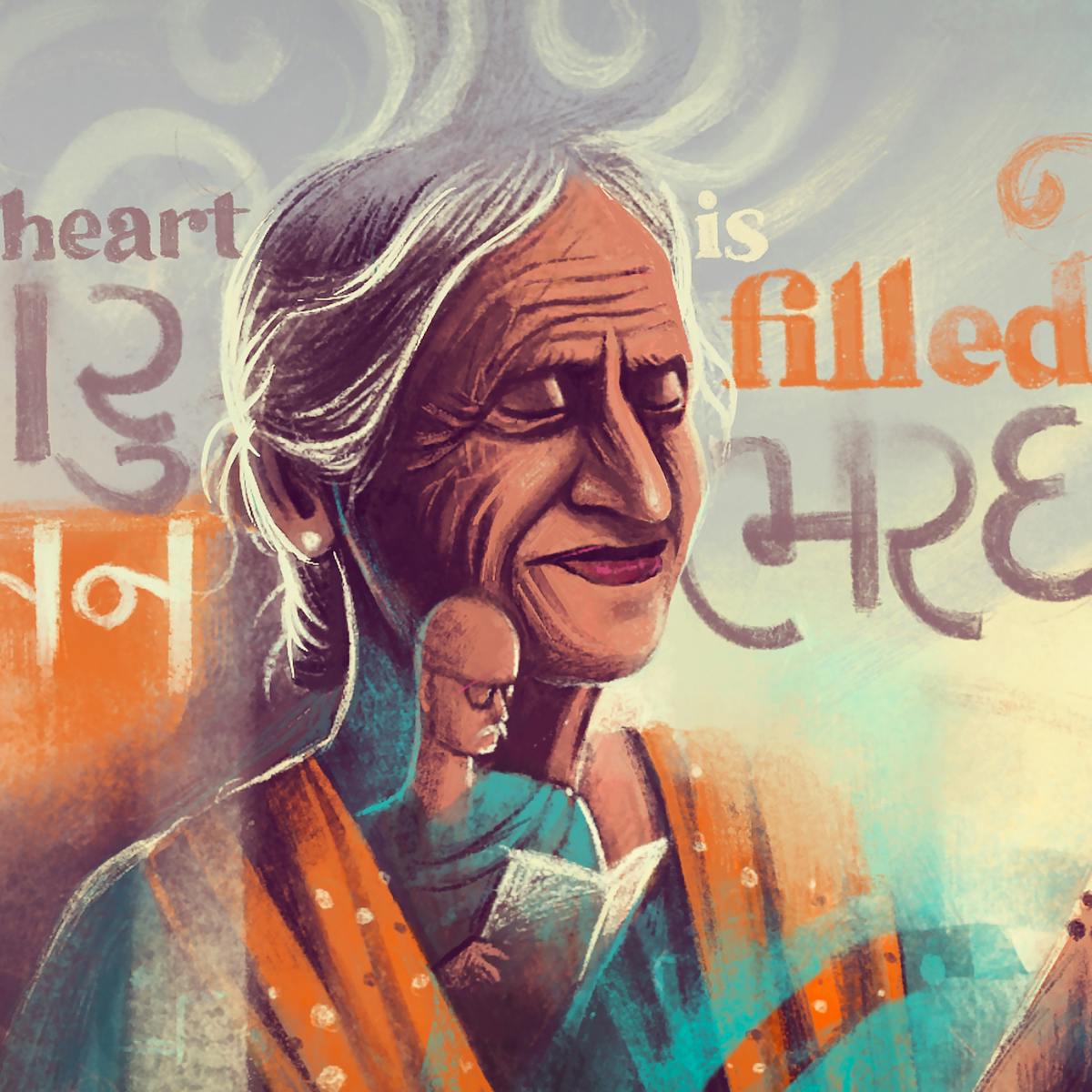Struggling to negotiate the space between Gujarati and English to talk to her grandmother about bereavement set Niyoshi Shah thinking. How do mental health workers provide care across languages? This is a particularly complex issue in India, where medicine and psychiatry use English to diagnose illness in a multilingual environment.
There was an accumulated silence under our conversations about my grandfather. We often talked about his habits and temperament, but my grandmother had not shared her experience of bereavement with us, though we lost him 20 years ago.
One evening, without provocation, she finally spoke. “Maaru mann bharayi jattu,” she said in Gujarati, our mother tongue. There is no perfect translation for mann. It was her metaphysical, sentient core that would brim with emotions when she thought of him.
I wanted to reciprocate and comfort her but couldn’t. I didn’t have the words to. I think in English, and can’t construct nuanced sentences on death and grief in any other language, so I let the conversation wilt. My incapacity made me wonder, though: how do people provide care across languages?
I got curious about mental health in particular, because it is built on a strange paradox. English is the lingua franca of psychiatry in India but the language isn’t accessible to most (like my grandmother). How do doctors connect with their patients? What challenges do they face in their routine?
English and privilege
Indian medical colleges first introduced psychiatric training in the 20th century. Their syllabus focused on Western constructs of mental health, and students were exposed to the latest research through publications like The Lancet.
As the discipline came of age, it often drew on other sciences to describe pathologies. For instance, ‘stress’ was borrowed from physics to denote a general cause of disorder that exerted pressure on the body and mind. The English lexicon for illness grew through loan words, but local knowledge systems could not keep pace due to colonial subjugation.
In the 1960s, after India gained independence, psychiatrists like N C Surya reflected on the need to contextualise their practice. He observed that English was alienating. “For the psychiatrist himself, it had… prestige value,” but the language did not resonate with those he sought to serve, for English is a privilege in Indian societies. It is most prevalent among the richer, more educated upper caste.
Even so, it is difficult to replace English in medicine, as it helps in standardising knowledge across countries. Besides, vernacular languages also have their own hierarchies, and can be chauvinistic. ‘Language’ is a labyrinthine topic, but before we give up, here is a glimpse of how it affects people on the ground.
Idiom.
Idioms and inferences
A Babelesque scene unfolds in most clinics as patients share their distress in their local tongue, which doctors then interpret into English for arriving at an assessment. This sometimes poses challenges. Sanjeev Jain is a psychiatrist at the National Institute of Mental Health and Neuro-Sciences (NIMHANS), Bengaluru. Many of his patients are poor and belong to various linguistic groups.
Jain sometimes hears them complain: “Sulpa divsi inda nam tale bhaaara aagtaide.” In Kannada, the main language of this region, this means, “My head has been heavy since a few days,” which can either signify stress or headaches. The exact use of the phrase needs to be inferred, which increases the risk of misdiagnosis. This is not exclusive to India or non-English countries, though. With regular waves of immigration, doctors in the West, too, grapple with multilingual communication.
There is an established strand of research that unpacks idioms of distress from different cultures to match them with psychiatric categories of illness. For example, two decades ago academics studied kufungisisa, a Shona idiom in Zimbabwe, to suggest that it is conceptually similar to ‘stress’, and can stem from social or spiritual anguish.
Though such research offers clarity and helps in extending the reach of services to neglected communities, it is problematic. It can lead to epistemic injustice as a variety of individual and cultural expressions of suffering get uniformly medicalised. Recently, kufungisisa was assimilated into the glossary of the ‘Diagnostic and Statistical Manual of Mental Disorders’ (DSM-5), and cross-referenced with major depression, among other conditions.
I, on my part, wonder about the very premise of this Sisyphean effort. As if one can put a telescope to words and map their universe of meanings. “Word work,” as Toni Morrison claimed in her speech for the Nobel Prize in Literature in 1993, “is sublime.”
Anecdotes and metaphors
Morrison also emphasised that it is in our hands whether language lives or dies, and the onus of nurturing it falls on us all. It isn’t the duty of writers alone. It is in our hands. With that humming in my head, I turn to patient records.
Most psychiatrists diligently transcribe what patients share with them – their personal histories, affliction, and responses to treatment. These records are maintained in English, which means that people’s original articulation is for ever lost: one can’t know how they describe mental health issues in their language. Can new technologies help with this gap in chronicling? In the West, many hospitals already use electronic health records (EHRs), and one can refer to their experience.
EHRs are highly structured for computational purposes. Doctors have to fill out a form with set parameters to complete their assessment. For instance, if they enter that their patient consumes alcohol, they may be led to a drop-down where they must choose the frequency of consumption.
Metaphor.
This can be restrictive, as one cannot record any details beyond the template on their screen. So doctors heavily rely on the notes section to describe the patient’s social background, their experience of illness, and other nuances that influence recovery. Can this free-text portion register vernacular languages? Can machine learning accurately interpret non-English entries? Artificial intelligence currently fumbles with any idiosyncratic use of language, such as abbreviations. How will it recognise our tendrilous metaphors for the disordered mind?
“People sometimes use anecdotes from movies and mythologies to explain how they are feeling. This is common among those who are not able to find precise language for their emotions,” Maya Sravannthi told me over a call. She is a psycho-oncologist in Hyderabad, and provides counselling to people with cancer and their families.
Artificial intelligence currently fumbles with any idiosyncratic use of language... How will it recognise our tendrilous metaphors for the disordered mind?
One of her patients compared his life to Karna from Mahabharata, for instance. “Meri zindagi toh Karna ki tarah hai. Amma ne janam diya par uske saath kabhi raha nahi mein” – I never got to live with my mother. Folded within this sentence is the stinging sense of being orphaned – and Sravannthi knew that because she knew the poem he was referring to. How will our mental health futures capture such nuance? How will they decipher the likenings through which we decipher life?
Silence and suffering
The second time I spoke to Jain we were joined by his colleague, Alok Sarin, who works at Sitaram Bhartia Hospital in New Delhi. Our conversation that morning took many turns, but it started with a simple question: Can you share three local words for distress that are difficult to interpret into English? Their response was perspective-altering.
Only focusing on words is somehow limiting. Silence also conveys suffering. Jain and Sarin explained how many women with a traditional background do not voice their emotional symptoms. “They will never say, ‘Humme gussa aa raha hai’ – I feel angry.
“They will not acknowledge their negative emotions because they aren’t supposed to have negative emotions. You need to decode their distress from auxiliary cues”– and that requires cultural sensitivity, which is not easy to come by, as prejudice can infect therapeutic encounters too.
As Jain acerbically said of caste-based hierarchies, “How will a Brahmin doctor have unconditional positive regard for his Dalit patient, from a sweeper’s colony, when he wouldn’t extend any consideration to this person otherwise [beyond the clinic’s door]? We can’t have universal humanism because our society is not universally humanistic.”
Silence.
Pidgin and psychology
It is clear that language, along with other social factors, affects service provision, but there are no systemic solutions for this issue. Most doctors simply learn on the job and develop their own approach to communication over time.
For instance, when a patient walks in, Sravannthi first checks if they have a proper understanding of their cancer diagnosis, because other sectors of health, too, struggle with multilingual communication. Some people are told, “Aapke sharir mein gannth hai,” which literally means, “You have a knot in your body.” Gannth (or knot) is the colloquial word for ‘tumour’, but it does not capture the complexities of cancer.
Using pidgin leads to confusion, which can add to a person’s distress. But meeting patients where they are, as Sravannthi does, requires time, which is a precious resource. Public hospitals can see up to 1,500 patients a day for psychiatric care. This leaves doctors with little time to think about language.
India’s mental health system is stretched thin. The country has only about 9,000 psychiatrists for a population of 1.3 billion, and most are based in cities. The state therefore relies on a network of health workers to deliver care to the non-urban population. At NIMHANS, they are trained to implement community programmes, and the curriculum is translated into Kannada and Hindi.
“But,” Jain explains, “interpretive models of psychology are seldom given emphasis. Our health workers aren’t trained to analyse people’s feelings. Among other reasons, at a simple level, this is because Indian languages have not incorporated the idea of an internal psyche as posited by Freudian theory, for example.
“There is no word for ‘psyche’, in fact. So our manuals mainly rely on cognitive and behavioural therapies that include doable actions. You teach a person how to relax without getting into why they are tense.”
Put another way, people are not asked about their hopes and fears – what makes and breaks them – because our dialect for mental health is suspended in the middle, between English and the vernacular.
Acknowledgement
In addition to the people quoted above, the author would like to thank Soumitra Pathare, psychiatrist, and director at the Centre for Mental Health Law & Policy (Pune) for sharing his experience of working across languages in mental health.
About the contributors
Niyoshi Shah
Niyoshi Shah completed her Master’s in Critical Writing at the Royal College of Art, London in 2018. Through her day job, she conducts research and designs communication for social and commercial projects. This gives her an insight into various domains, including public and mental health, fashion, cultural history and tech, and lends to her writing. She is currently working as a consultant for a design research and strategy studio, and is based in Mumbai in India.
Ranganath Krishnamani
Ranganath is a multidisciplinary designer specialising in illustration, product design and fine arts. Founder of Liquidink Design studio, he has helped several start-ups in India develop engaging digital experiences and product design. A Bangalorean by heart, he draws inspiration to create from life around him, vintage architecture, culture, street art and machinery. When he is not drawing in his sketchbook, he loves to explore new trails on his bicycle.


